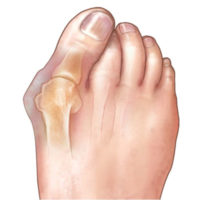 Early in my career I treated a lot of feet. As a freshly minted myofascial therapist I had been taught that we could “fix” bunions, hammer and claw toes. Well, I saw quickly that it is a common problem had plenty of practice in a short time!
Early in my career I treated a lot of feet. As a freshly minted myofascial therapist I had been taught that we could “fix” bunions, hammer and claw toes. Well, I saw quickly that it is a common problem had plenty of practice in a short time!
A bunion is a deformation of the first metatarsal joint behind the big toe. It typically involves deviation of the big toe to the center of the foot while the metatarsal joint deviates the opposite direction. Bunions may be painless at first but over time inflammation of the first metatarsal joint causes swelling and pain. Gout, rheumatoid arthritis and other inflammatory conditions may complicate the picture.
It is surprising that there is little information available about the cause of bunions, despite wide agreement that there appear to be hereditary aspects, they seem to be more common in women and with age. Great! That helps NOT AT ALL get to the bottom of the average bunion!
After over a decade of training, study and treatment I can share three factors that may converge together to greatly increase your risk of developing bunions! I will also explain how you can stop the progression of a bunion and reverse most of the damage in mild to moderate cases.
- Bony structure of the foot – Morton’s Foot Structure or Morton’s Toe. The first metatarsal, behind the big toe, is short compared to the second metatarsal, next to it. This can corrected with simple supportive insoles.
- Muscular attachments within the foot. When the connection of ABductor Hallucis muscle to your big varies above or below the center line, activating this muscle will cause the big toe to extend up, or flex down. The tendency of the aDductor hallucis to pull the toe towards the center line of the foot can be reduced by minimizing taut bands in this muscle.
- External rotation at the hip. When the leg is externally rotated, the “toe-off” phase of the normal gait is altered and the big toe is pushed to the center with each step. Tight internal hip rotators can be stretched effective at home with some simple exercises.
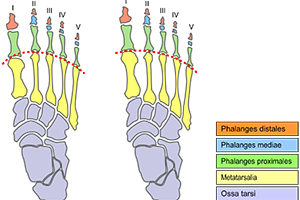 The metatarsal bones behind the toes vary in relative length. For most feet, a smooth curve can be traced through the joints at the bases of the toes. But in Morton's Foot Structure or Morton's Toe, the line has to bend more sharply to go through the base of the big toe, as shown in the diagram.
This is because the first metatarsal, behind the big toe, is short compared to the second metatarsal, next to it.
This changes the way your foot is supported. Therefore, it can contribute to myofascial pain and dysfunction by increasing overload on key muscles. This common skeletal variation makes your foot want to pronate.
So it makes sense that muscles that have a significant job to provide stability would be unhappy. You can correct Morton's Foot Structure with a posture control insert.
The metatarsal bones behind the toes vary in relative length. For most feet, a smooth curve can be traced through the joints at the bases of the toes. But in Morton's Foot Structure or Morton's Toe, the line has to bend more sharply to go through the base of the big toe, as shown in the diagram.
This is because the first metatarsal, behind the big toe, is short compared to the second metatarsal, next to it.
This changes the way your foot is supported. Therefore, it can contribute to myofascial pain and dysfunction by increasing overload on key muscles. This common skeletal variation makes your foot want to pronate.
So it makes sense that muscles that have a significant job to provide stability would be unhappy. You can correct Morton's Foot Structure with a posture control insert.
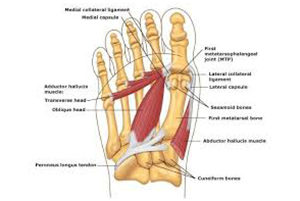 The ABductor Hallucis muscle is normally attached to the side of the big toe and allows the toes to “splay” out to the side. When this attachment varies above or below the center line, activating this muscle will cause the big toe to extend up, or flex down. Try it with you feet and see what happens! When this attachment varies, there is nothing to oppose the action of the aDductor hallucis, which pulls the big toe towards the center of the foot. Although this is hereditary, the tendency of the aDductor hallucis to pull the toe towards the center line of the foot can be reduced by minimizing taut bands in this muscle.
The ABductor Hallucis muscle is normally attached to the side of the big toe and allows the toes to “splay” out to the side. When this attachment varies above or below the center line, activating this muscle will cause the big toe to extend up, or flex down. Try it with you feet and see what happens! When this attachment varies, there is nothing to oppose the action of the aDductor hallucis, which pulls the big toe towards the center of the foot. Although this is hereditary, the tendency of the aDductor hallucis to pull the toe towards the center line of the foot can be reduced by minimizing taut bands in this muscle.
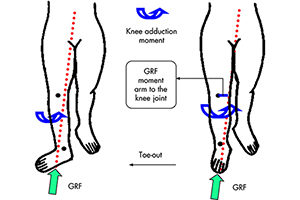 During the toe-off phase of a normal gait, much of the force is transmitted from the big toe, through the first metatarsal and back to the heel. When the leg is externally rotated, the "toe-off" phase of the normal gait is altered and the big toe is pushed to the center with each step.
Stand up and look down at your feet. Are you "duck footed"? Tight internal hip rotators may hereditary or may be a learned behavior.
Either way, they can be stretched effectively at home with some simple exercises.
During the toe-off phase of a normal gait, much of the force is transmitted from the big toe, through the first metatarsal and back to the heel. When the leg is externally rotated, the "toe-off" phase of the normal gait is altered and the big toe is pushed to the center with each step.
Stand up and look down at your feet. Are you "duck footed"? Tight internal hip rotators may hereditary or may be a learned behavior.
Either way, they can be stretched effectively at home with some simple exercises.
So, how do you stack up? Each factor increases your likelihood of bunions. If you have just one or two, you may be fine. If you were a “yes” for all three, chances are you already have a bunion or can see the beginnings of one. Do not despair – treatment is possible! Click here for more information on the treatment approach for bunions.
It takes time – and dedication – to make a significant change in your feet. However, it can be done. I’ve seen positive results many times. If you are having similar issues, you may find that a session or two to identify and treat root causes of your individual case is helpful.
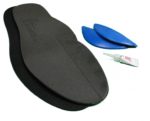 First, treatment begins with insoles for the bony deformation of Morton’s Foot. Inexpensive posture control insoles will support the first metatarsal bone, reduce pronation and shift weight bearing to a more natural position within the foot
First, treatment begins with insoles for the bony deformation of Morton’s Foot. Inexpensive posture control insoles will support the first metatarsal bone, reduce pronation and shift weight bearing to a more natural position within the foot
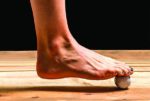 Next, we treat aDductor hallucis muscle on the sole of the foot. For self-care, we recommend using a golf ball or superball of about 1″ diameter to slowly and deeply compress the aDductor hallucis muscles on the sole of the foot. For office workers this can be done under the desk while working.
Next, we treat aDductor hallucis muscle on the sole of the foot. For self-care, we recommend using a golf ball or superball of about 1″ diameter to slowly and deeply compress the aDductor hallucis muscles on the sole of the foot. For office workers this can be done under the desk while working.
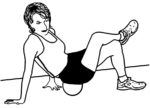 Finally, also want to reduce external rotation at the hip by stretching the internal hip rotator muscles. During treatment, we will compress and stretch the internal rotators of the hip.
Finally, also want to reduce external rotation at the hip by stretching the internal hip rotator muscles. During treatment, we will compress and stretch the internal rotators of the hip.
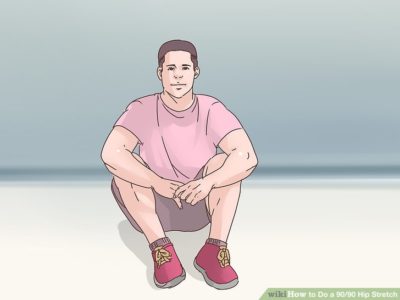
For self-care, the “90/90” series of stretches shown below stretch both the external and internal hip rotators equally. Begin seated on the floor with the knees bent and both feet on the floor.
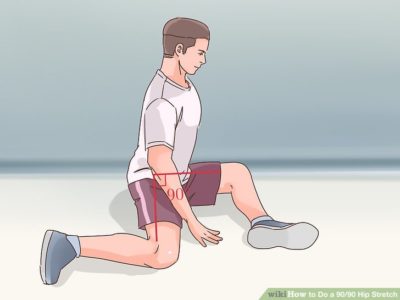
Next, rotate the legs so that the knees are bent in opposite 90 degree bends.
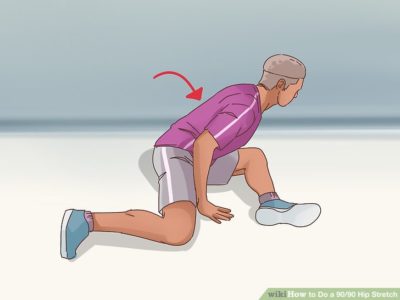
Deepen the external rotator stretch by hinging forward.
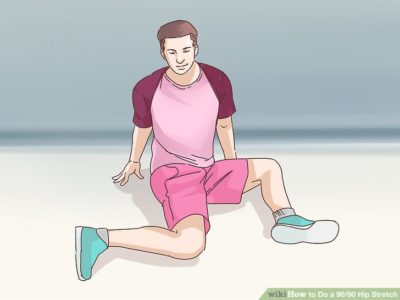
Deepen the internal rotator stretch by turning towards the knee of the back leg and leaning back.
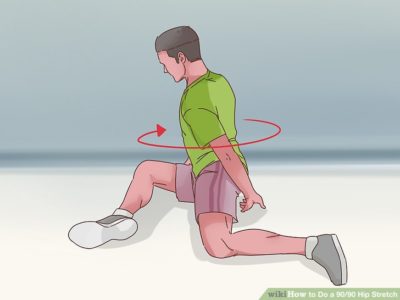
Return to center, switch sides and repeat on the other side.
Finally, we want to reduce inflammation – both from the underlying bunion and the rest of the treatment of the foot. We use acoustic compression with the Well-Wave to treat and reduce inflammation of the first metatarsal joint.
If you are having similar issues, you may find that a session or two to identify the root causes for your individual case is helpful. Call today to make an appointment!
